A new type of coral I discovered, here is a link to the fossilforum wheere the work is being done....b
http://www.thefossilforum.com/index.php?/topic/57287-odd-coral-type-from-tampa/
pix:


Don
http://www.thefossilforum.com/index.php?/topic/57287-odd-coral-type-from-tampa/
pix:

Odd Coral Type From Tampa
Started by
luxefaire,
36 posts in this topic
Interesting. This specimen really does not look at all like any of
the scleractinian corals I have collected or seen from south Florida.
There is a resemblance to a Paleozoic tabulate coral, but I think that
is just superficial, perhaps an artefact of the way the specimen has
been silicified. Anyway, a pdf of Weisbord 1973, "New and Little-known
Corals from the Tampa Formation of Florida", is available here. You might compare your specimen to Aveopora tampae (pg 37-38 and plate 6 fig 406, plate 7 figs 4-5 in the pdf).
Don
Don
goatinformationist,
Bone Daddy and
JohnJ finds this informative
Wouldn't it be nice to have genetic material to figure out what
the corals have really been up to all this time. I think they are all
half breeds.
what happened to the septa? (or septae)
"There has been an alarming increase in the number of things I know nothing about." - Ashleigh Ellwood Brilliant
“Try to learn something about everything and everything about something.” - Thomas Henry Huxley
>Paleontology is an evolving science.
>May your wonders never cease!
“Try to learn something about everything and everything about something.” - Thomas Henry Huxley
>Paleontology is an evolving science.
>May your wonders never cease!
I wonder if it might actually be a hymenopteran (wasp) nest? Some of
them (such as yellowjackets) nest in the ground and could possibly be
subject to mineralization under certain circumstances I suppose. That
could explain the resemblance to "honeycomb coral".
Don
Don
Personally, I think the hexagons are too irregular for it to be a wasp nest.
Innocentx finds this informative
"There has been an alarming increase in the number of things I know nothing about." - Ashleigh Ellwood Brilliant
“Try to learn something about everything and everything about something.” - Thomas Henry Huxley
>Paleontology is an evolving science.
>May your wonders never cease!
“Try to learn something about everything and everything about something.” - Thomas Henry Huxley
>Paleontology is an evolving science.
>May your wonders never cease!
There do appear to be some vestiges of septa, and I agree that
brood chambers would be more regular and only one bee length deep. They
could have collapsed onto each other, but it seems like there would more
gaps and distortion if that were the case.
Thank you very much for the replies, it was retrieved with a lot
of other material from a submerged vein at Ballast Point so even though
the wasp nest idea is neat, I dont think it is that....a lot of the
corals here are very well preserved, and the alveopora types in the
aforementioned pdf are not these, I have many examples of Alveopora
tampa and they are distinctly different. This has never been identified
by any of the people studying this reef of th aTampa
Formation.....thanks very much again, future replies welcomed....b.
Edited by luxefaire
Edited by luxefaire
my Guess is Mantastraea without the septa being preserved?
"Absence of evidence is not evidence of absence"_ Carl Sagen
No trees were killed in this posting......however, many innocent electrons were diverted from where they originally intended to go.
" I think, therefore I collect fossils." _ Me
"When you have eliminated the impossible, whatever remains, however improbable, must be the truth."__S. Holmes
"can't we all just get along?" Jack Nicholson from Mars Attacks
No trees were killed in this posting......however, many innocent electrons were diverted from where they originally intended to go.
" I think, therefore I collect fossils." _ Me
"When you have eliminated the impossible, whatever remains, however improbable, must be the truth."__S. Holmes
"can't we all just get along?" Jack Nicholson from Mars Attacks
Do you have the wherewithal to cut it? There may be septa preserved inside.
"There has been an alarming increase in the number of things I know nothing about." - Ashleigh Ellwood Brilliant
“Try to learn something about everything and everything about something.” - Thomas Henry Huxley
>Paleontology is an evolving science.
>May your wonders never cease!
“Try to learn something about everything and everything about something.” - Thomas Henry Huxley
>Paleontology is an evolving science.
>May your wonders never cease!
Thank you for your replies to this query. I have added some
pictures to one of my blogs which relate to bulletin 56 for anyone
interested. There are some more examples of this unknown type, which
appears tabulate in some ways, but may be Favites or Favistina. My
query here was part of a multifaceted investigation I ndertook when I
finally realized I was going to have to spend some time to identify this
type. I have found some pictures which indicate to me Favistina or
Favites and there are a number of those types already recorded on the
reef at Tampa. This un-named coral type is fairly common there, and
manifests as true silica pseudomorph regularly, sometimes of very fine
quality.
The link: treasurehuntingwithbillgallagher.blogspot.com.
Back to the initial request for information here, concerning the type of coral above, I have also come across several types by rereading bulletin 56 which were named but not really, tentatively, and there are no examples pictured of these types, in particular: endopachys tampae, orbicella (Montastrea?) cellulosa, anthemiphyllia ?, antillocyathus. All inputs welcome concerning these coral types.....b
PS I CAN AND DO CUT THESE TYPES REGULARLY AND I WILL GET A PICTURE UP OF A CROSS SECTION NEXT TIME I AM ONLINE...THANK YOU AGAIN....B
The link: treasurehuntingwithbillgallagher.blogspot.com.
Back to the initial request for information here, concerning the type of coral above, I have also come across several types by rereading bulletin 56 which were named but not really, tentatively, and there are no examples pictured of these types, in particular: endopachys tampae, orbicella (Montastrea?) cellulosa, anthemiphyllia ?, antillocyathus. All inputs welcome concerning these coral types.....b
PS I CAN AND DO CUT THESE TYPES REGULARLY AND I WILL GET A PICTURE UP OF A CROSS SECTION NEXT TIME I AM ONLINE...THANK YOU AGAIN....B
Clearly, you are no neophyte, and your quest is fired by more than idle curiosity!
Speaking for myself, I hope to learn from your efforts
Speaking for myself, I hope to learn from your efforts
"There has been an alarming increase in the number of things I know nothing about." - Ashleigh Ellwood Brilliant
“Try to learn something about everything and everything about something.” - Thomas Henry Huxley
>Paleontology is an evolving science.
>May your wonders never cease!
“Try to learn something about everything and everything about something.” - Thomas Henry Huxley
>Paleontology is an evolving science.
>May your wonders never cease!
Favistina is an Ordovician colonial rugosan coral with well
developed primary and secondary septa in which the primaries reach to
(or close to) the center of the corallite, but do not twist or fuse to
form a columnellar structure (that would make it a Cyathophylloides). Favites is a "brain coral", very different from your mystery specimens. Did you mean Favosites? That is a lower/middle Paleozoic tabulate coral. There is a superficial similarity in that both Favosites and your coral look like colonies of hexagonal corallites. However Favosites
has a distinct structure to the corallite wall, including pores that
penetrate the wall and allow communication between corallites. I don't
know if you can see that level of detail in your specimens, as it seems
to me they are recrystallized so that such detail would be obscured if
it was ever present. At any rate it seems unlikely to me that tabulate
corals would have disappeared from the fossil record in the late
Paleozoic, reappear as a "Lazarus taxa" in the Oligocene/Miocene, and
then go extinct for good (as they have never been seen in modern
oceans).
You might want to check some of the references on Neogene corals from islands in the Caribbean. Apparently many of the corals present in the Golden Gate member of the Tamiami formation are affiliated with corals from Puerto Rico and elsewhere in the Caribbean, and California. Some genera are (supposedly) living in the present-day South Pacific, though they are now extinct on the Atlantic side of the Central American isthmus.
Anyway, your specimens are certainly intriguing!
Don
You might want to check some of the references on Neogene corals from islands in the Caribbean. Apparently many of the corals present in the Golden Gate member of the Tamiami formation are affiliated with corals from Puerto Rico and elsewhere in the Caribbean, and California. Some genera are (supposedly) living in the present-day South Pacific, though they are now extinct on the Atlantic side of the Central American isthmus.
Anyway, your specimens are certainly intriguing!
Don
You,
goatinformationist and
Auspex finds this informative
try the paleontology section of the University of Florida site: paleontology, fossils, invertebrates,gallery
"Absence of evidence is not evidence of absence"_ Carl Sagen
No trees were killed in this posting......however, many innocent electrons were diverted from where they originally intended to go.
" I think, therefore I collect fossils." _ Me
"When you have eliminated the impossible, whatever remains, however improbable, must be the truth."__S. Holmes
"can't we all just get along?" Jack Nicholson from Mars Attacks
No trees were killed in this posting......however, many innocent electrons were diverted from where they originally intended to go.
" I think, therefore I collect fossils." _ Me
"When you have eliminated the impossible, whatever remains, however improbable, must be the truth."__S. Holmes
"can't we all just get along?" Jack Nicholson from Mars Attacks
Thank you for the replies, and especially Don, I am newbie as far as
corals go, just good at collecting them, but I am catching up and I
appreciate the help....here are 2 pix of the coral sliced, I may have to
slice across the polyps, looking at it now, there do not seem to be any
septa visible in this coral. None of the4 specimens I have collected
possess anything like septa....is it possibly a sponge?
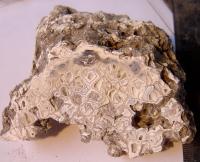
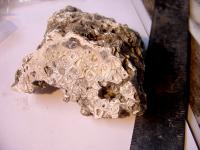


It looks to be heavily altered; geodized, even.
"There has been an alarming increase in the number of things I know nothing about." - Ashleigh Ellwood Brilliant
“Try to learn something about everything and everything about something.” - Thomas Henry Huxley
>Paleontology is an evolving science.
>May your wonders never cease!
“Try to learn something about everything and everything about something.” - Thomas Henry Huxley
>Paleontology is an evolving science.
>May your wonders never cease!
Thank you for the replies. For the record I will log some of my
activities here concerning the agatized corals of Tampa Bay. I began
collecting Tampa agatized coral in the late 70s during my time at
Macdill AFB. I stayed in Tampa after my enlistment was up, and went to
work at Tampa International, 1981 or so. I left Tampa in the middle
80s, but I have been back since then many times, in quests for corals.
The whole Gadsen peninsula, South Tampa, is the #1 search area for these rare fossils, and Ballast point is about halfway up the eastern side of said peninsula, with Macdill encompassing the entire bottom of it. Ballast point is where the vein representing the old reef comes cloest to the surface. Over by the Dale Mabry gate to Macdill AFB there was a lake dug in the 60s, literally tons of agatized coral came from the veins exposed around 30 feet down when that lake was first excavated. The best thing I ever saw from that dig were these really huge agatized oyster shells with crystalline interiors, very rare, some were over a foot long, pseudomorphic geodes, 100% agatized. Almost all that chalcedony was light brown colored.
The late 70s and early 80s began modern drainage at Ballast Point because there were big plans for many more buildings out there on the waterfront. A lot of deep pipe was laid for storm sewers and the like, along with retention basins and drains. This was good hunting. After the work day many diggers went out and worked the piles of dirt that had been dug out of the way to lay the new pipe. It took many months for each job so there was a lot of digging. One day during the early 80s I got to a good spot over by Shell Point Road just as the crane was bucketing out a large wet bunch of dirt. Dumping it onto the nearest pile, the machine continued working as I watched an agatized coral head the size of a basketball roll down the dirt pile. The vast majority of coral from the land areas is brown in color. The reds from around the horse stables across from Ballast Point pier occurred because of iron, and the blacks from out in the bay itself were the result of sulphur springs. Supposedly the blacks are the rarest color, though many people, myself included, really like the reds too.
The coral had been a source of interest to me since I was a youngster because I had a small piece in my mineral and lapidary collection as a boy. It is the mineral aspect of the formation which initially drew collectors, including me, to "Tampa Bay Chalcedony". The preservation of the coral types did not come up for some time, and I was mostly a student of Lapidary. The agatized coral taught me how to cut quartz, and because it sold well I was able to finance my shop equipment somewhat while working with it.
The identification of corals by type is somewhat a solitary endeavor on my part, in relation to the other collectors and diggers of the rock who I have known, and I have known many. Because I have developed different ways to retrieve these fossils, I also acquire types of high detail and quality, and this makes it easier to notice and be enthusiastic about the actual fossil aspects. Most people though are after the agate itself, the geodes. Appreciation of the chalcedony is the root of the so-called "Curio" value of the agatized coral from Tampa.
My latest collecting took place across a full year during 2013 and 2014. The biggest advantage I had was finding a very small area that had never been dug, out away from shore. This little area I had found was considered inaccessible, due to water depth at the lowest tides, so after locating it I was able to skin dive and collect right out of the original pockets and veins for a while. It took a year to work it out. There was a lot of eroded stuff there, water tumbled, good for collectors of agate, but also some veins and pockets of silex with intact layers which were very interesting. Many of those specimens are the best I have ever seen anywhere.
There are anamolies and unnamed things out there on the reef at Ballast Point in south Tampa, things that were preserved there that no one has seen anywhere else, but if not immediately identifiable they are relegated to the great unknown. Some seem to be tube animals or other exoskeletal detritus from the bottom of the reef. When you are digging in the layer, in the silex, in the clay, it feels a lot like coffee grounds, but sharper, and it is full of microfossils and shells and fragments; most are highly silicified. Supposedly these geodes formed in limestone which then became clay after being exposed to water via fluctuating water tables. The limestone dissolved leaving the silex clay and the chalcedony casts/geodes.
I have published 4 or 5 times on agatized coral, mostly in treasure hunting magazines as rock and gem related articles, and once in Lapidary Journal (Ancient Lapidary Arts Florida Style, 1980 or 1981) concerning the use of the solid agatized coral of the Tampa Formation by early people to make weapons and tools. Most of the solid agatized coral heads which comprise the lions share of the Tampa Formation are Siderastrea I think. The Native Americans heat treated the siliceous head material and it turned very colorful and glass-like, much akin to obsidian in its working properties, just a little harder. Most of the Valdosta Georgia geode heads are Siderastrea also. The coral at Taylor county was mostly finger corals, and probably was a lot like the reef at Ballast Point at one time, though the pieces are older, and there is hardly any real evidence of coral on the geodes from Taylor county. The popularity of the agatized corals from Florida and south Georgia is almost totally dependent on their curio value. The Taylor county and Valdosta Georgia deposits are almost depleted, as are the accessible places in the bay at Ballast Point, which has been dug extensively since the 1700s.
The whole Gadsen peninsula, South Tampa, is the #1 search area for these rare fossils, and Ballast point is about halfway up the eastern side of said peninsula, with Macdill encompassing the entire bottom of it. Ballast point is where the vein representing the old reef comes cloest to the surface. Over by the Dale Mabry gate to Macdill AFB there was a lake dug in the 60s, literally tons of agatized coral came from the veins exposed around 30 feet down when that lake was first excavated. The best thing I ever saw from that dig were these really huge agatized oyster shells with crystalline interiors, very rare, some were over a foot long, pseudomorphic geodes, 100% agatized. Almost all that chalcedony was light brown colored.
The late 70s and early 80s began modern drainage at Ballast Point because there were big plans for many more buildings out there on the waterfront. A lot of deep pipe was laid for storm sewers and the like, along with retention basins and drains. This was good hunting. After the work day many diggers went out and worked the piles of dirt that had been dug out of the way to lay the new pipe. It took many months for each job so there was a lot of digging. One day during the early 80s I got to a good spot over by Shell Point Road just as the crane was bucketing out a large wet bunch of dirt. Dumping it onto the nearest pile, the machine continued working as I watched an agatized coral head the size of a basketball roll down the dirt pile. The vast majority of coral from the land areas is brown in color. The reds from around the horse stables across from Ballast Point pier occurred because of iron, and the blacks from out in the bay itself were the result of sulphur springs. Supposedly the blacks are the rarest color, though many people, myself included, really like the reds too.
The coral had been a source of interest to me since I was a youngster because I had a small piece in my mineral and lapidary collection as a boy. It is the mineral aspect of the formation which initially drew collectors, including me, to "Tampa Bay Chalcedony". The preservation of the coral types did not come up for some time, and I was mostly a student of Lapidary. The agatized coral taught me how to cut quartz, and because it sold well I was able to finance my shop equipment somewhat while working with it.
The identification of corals by type is somewhat a solitary endeavor on my part, in relation to the other collectors and diggers of the rock who I have known, and I have known many. Because I have developed different ways to retrieve these fossils, I also acquire types of high detail and quality, and this makes it easier to notice and be enthusiastic about the actual fossil aspects. Most people though are after the agate itself, the geodes. Appreciation of the chalcedony is the root of the so-called "Curio" value of the agatized coral from Tampa.
My latest collecting took place across a full year during 2013 and 2014. The biggest advantage I had was finding a very small area that had never been dug, out away from shore. This little area I had found was considered inaccessible, due to water depth at the lowest tides, so after locating it I was able to skin dive and collect right out of the original pockets and veins for a while. It took a year to work it out. There was a lot of eroded stuff there, water tumbled, good for collectors of agate, but also some veins and pockets of silex with intact layers which were very interesting. Many of those specimens are the best I have ever seen anywhere.
There are anamolies and unnamed things out there on the reef at Ballast Point in south Tampa, things that were preserved there that no one has seen anywhere else, but if not immediately identifiable they are relegated to the great unknown. Some seem to be tube animals or other exoskeletal detritus from the bottom of the reef. When you are digging in the layer, in the silex, in the clay, it feels a lot like coffee grounds, but sharper, and it is full of microfossils and shells and fragments; most are highly silicified. Supposedly these geodes formed in limestone which then became clay after being exposed to water via fluctuating water tables. The limestone dissolved leaving the silex clay and the chalcedony casts/geodes.
I have published 4 or 5 times on agatized coral, mostly in treasure hunting magazines as rock and gem related articles, and once in Lapidary Journal (Ancient Lapidary Arts Florida Style, 1980 or 1981) concerning the use of the solid agatized coral of the Tampa Formation by early people to make weapons and tools. Most of the solid agatized coral heads which comprise the lions share of the Tampa Formation are Siderastrea I think. The Native Americans heat treated the siliceous head material and it turned very colorful and glass-like, much akin to obsidian in its working properties, just a little harder. Most of the Valdosta Georgia geode heads are Siderastrea also. The coral at Taylor county was mostly finger corals, and probably was a lot like the reef at Ballast Point at one time, though the pieces are older, and there is hardly any real evidence of coral on the geodes from Taylor county. The popularity of the agatized corals from Florida and south Georgia is almost totally dependent on their curio value. The Taylor county and Valdosta Georgia deposits are almost depleted, as are the accessible places in the bay at Ballast Point, which has been dug extensively since the 1700s.
goatinformationist,
Innocentx,
Plantguy and
2 others
finds this informative
Hi Don (FossilDAWG) thanks for the information on this coral it is a
good lead, and to all who replied, if I discover anything I will post
here in the future....best wishes and happy holidays....Bill
No septa, no tabulae, no pores on the surface, no spicules, just
irregular polygons with aleatoric distribution, some of them having a
round knob in the center. I think, it looks close to a septarian, or
better a counter septarian structure as we have seen before in A.
Seilacher's examples, giving a geological, not a biological origin.
Innocentx finds this informative
I like the photos on your blog and I think you're onto something here, though I certainly don't know what it is.On 9/10/2015 at 0:04 PM, luxefaire said:treasurehuntingwithbillgallagher.blogspot.com
Thank you to all who have replied, a lot of the information has been
helpful, and all of it has been interesting. I have many examples of
this...thing....it is a common type, as far as that goes at Ballast
Point. In 2014 I dug a pocket there that was almost entirely this type,
and that happens a lot out there, the pockets sometimes have
predominant species within, like that section of the reef was where
something got started and then reproduced over long periods of time
before dying and fossilizing.... here are some additional pictures for
those of you more well versed in corals than I am....maybe they show
more detail of useful type, I hope they are not redundant....as to the
tamiami formation I have collected some of that stuff south of tampa, it
is too recent to be considered I think, although Dons suggestions led
me to a site called http://geokogud.info/
and I have found some interesting things there that may be indicative.
I think the effort here is worth the time, if it is a different type of
coral not classified it is somewhat important, no? It would be cool to
figure it out here.
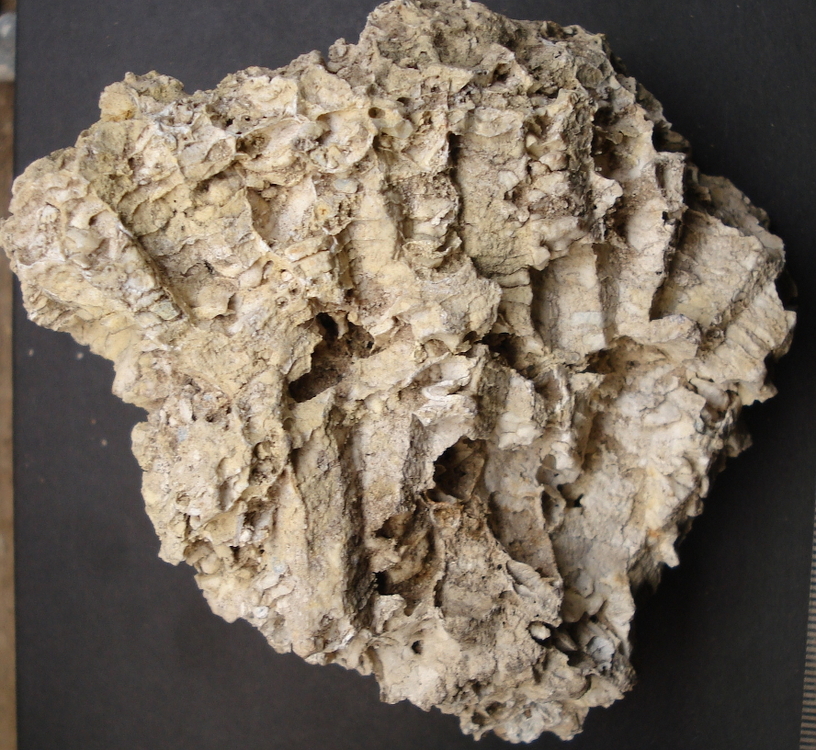
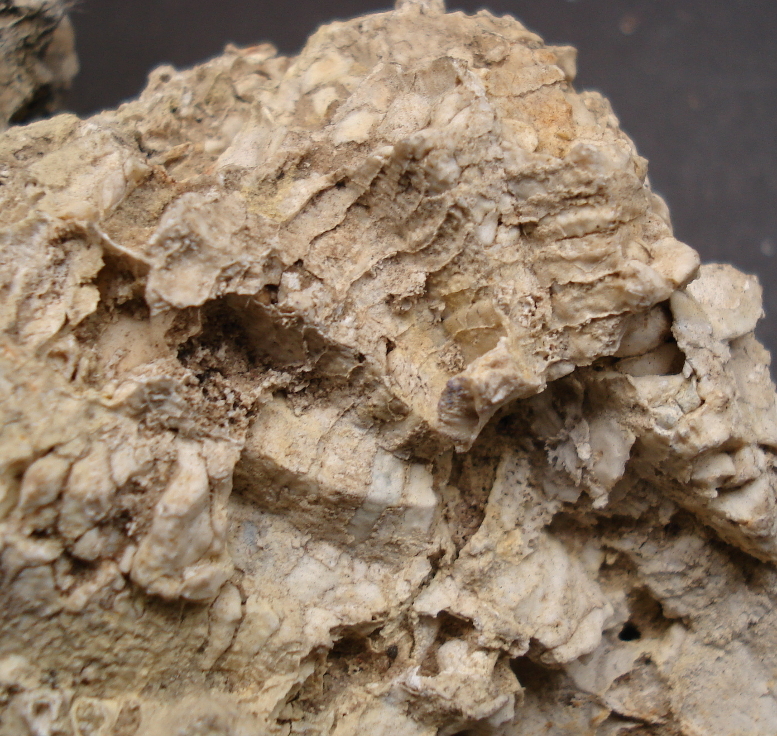

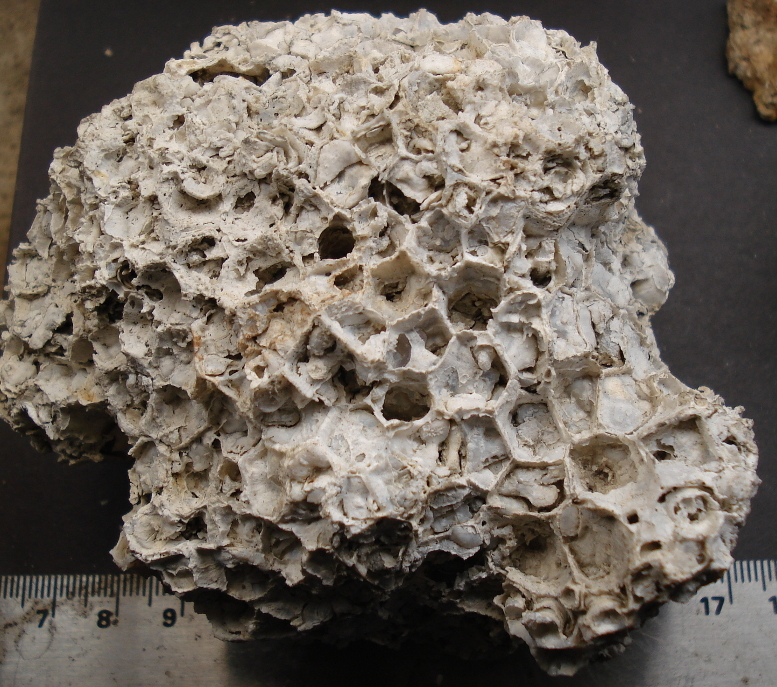
Innocentx finds this informative
Your examples do very much resemble the favosites pictured on this link. (nice link!)
On 12/21/2016 at 6:13 PM, luxefaire said:
Well I have been busy and there is light at the end of the tunnel. By
taking what I have learned here, along with things from bulletin56 and
googs, I have had a little success in maybe matching this coral with a
relevant picture.
I found one piece of this stuff with somewhat intact characteristics, (pix #1 and #2) and then found a picture of coral which resembled that pretty well, but on an architectural page illustrating hexagonal and polygonal forms for building (http://design.epfl.ch/piraeus/2-day-to-day/3-process/cs-coral-i). Tracing that picture brought me to a blog by a cool dude who likes taking pictures underwater in his tropical retirement paradise in Vietnam (http://www.messersmith.name/wordpress/2009/01/02/ocean-patterns/) if I am interpreting that correctly. Better pix: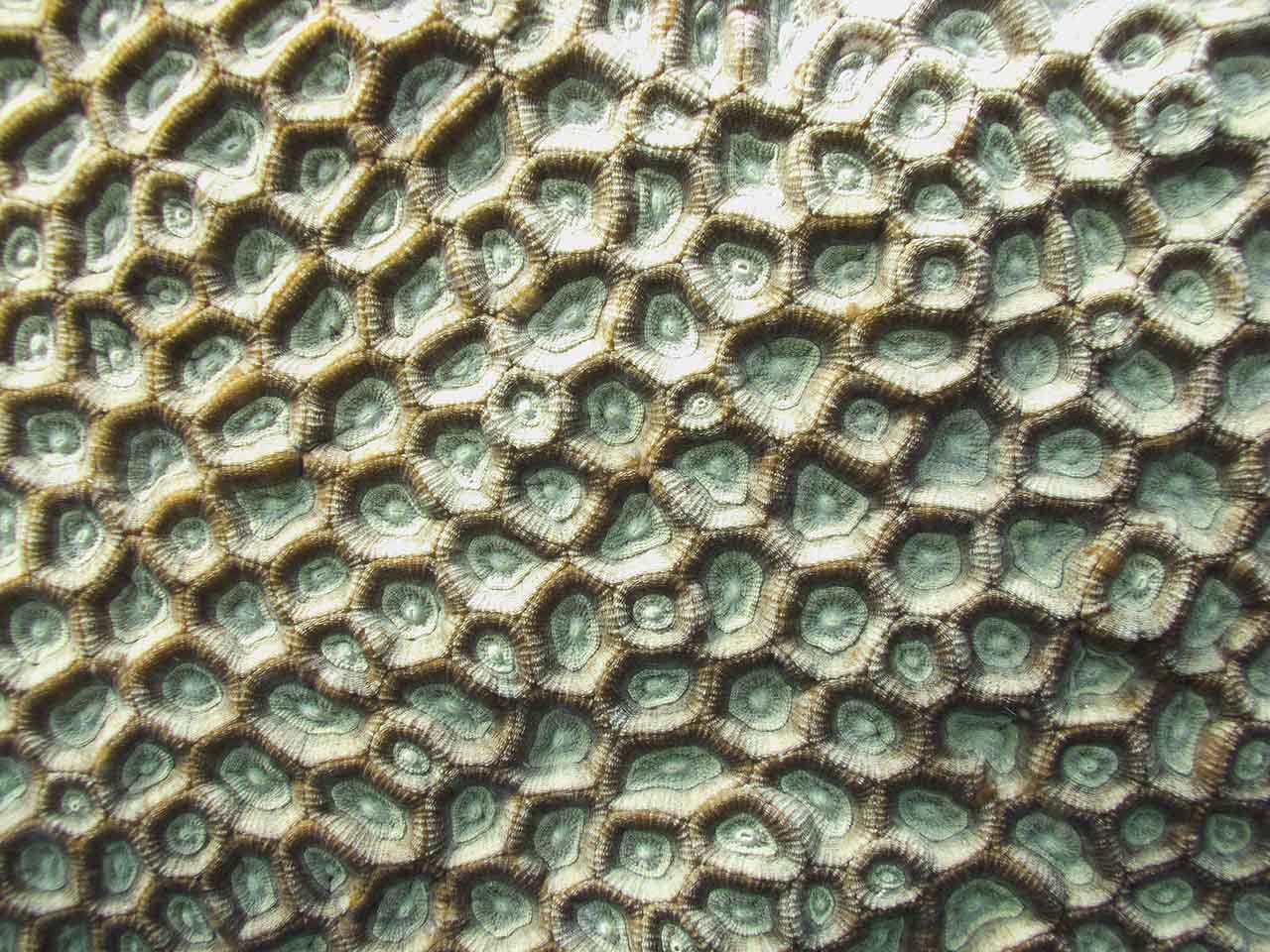
Anyway, nobody has a species name though the architecurals are calling it star coral. Maybe a coral specuialist here can help. So this appears to be a deteriorated form of something (Montastrea, Favosites, Orbicella?). It is pretty common on the Ballast Point reef of the Tampa Formation, which I think is shallow water stuff, versus deepwater stuff. In the last two pictures the reader can see a phenomena common to this type of specimen also, these little polygonal or hexagonal discus type thingies are "Stacked" in the tubes of the coral, and can be removed a lot of the time, unless the specimen is extremely well silicified.
Again, thanks for looking, any help greatly appreciated.
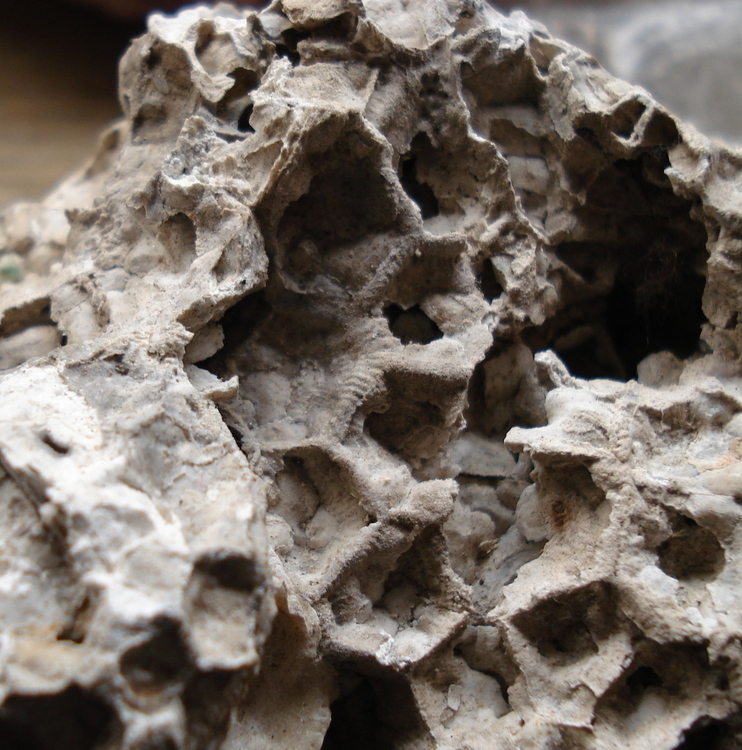
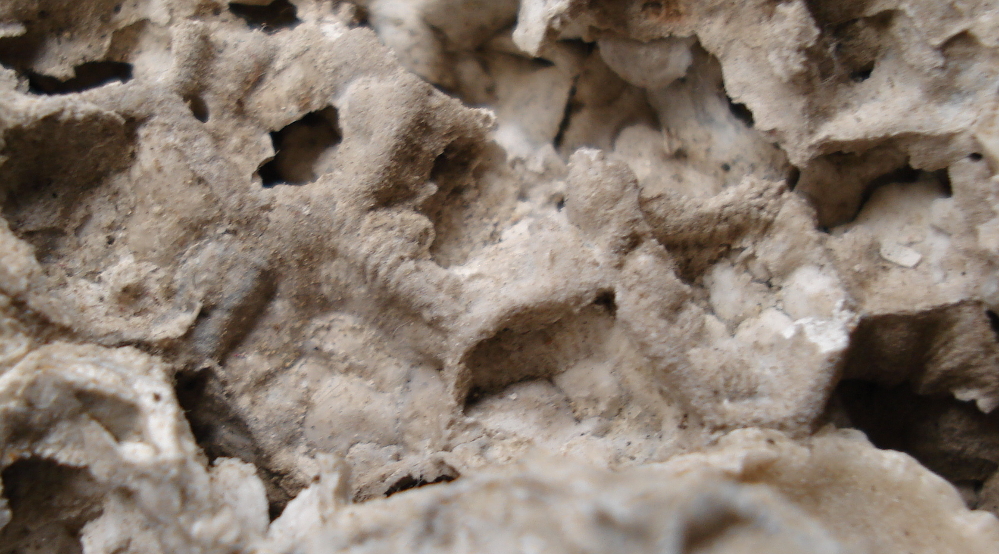
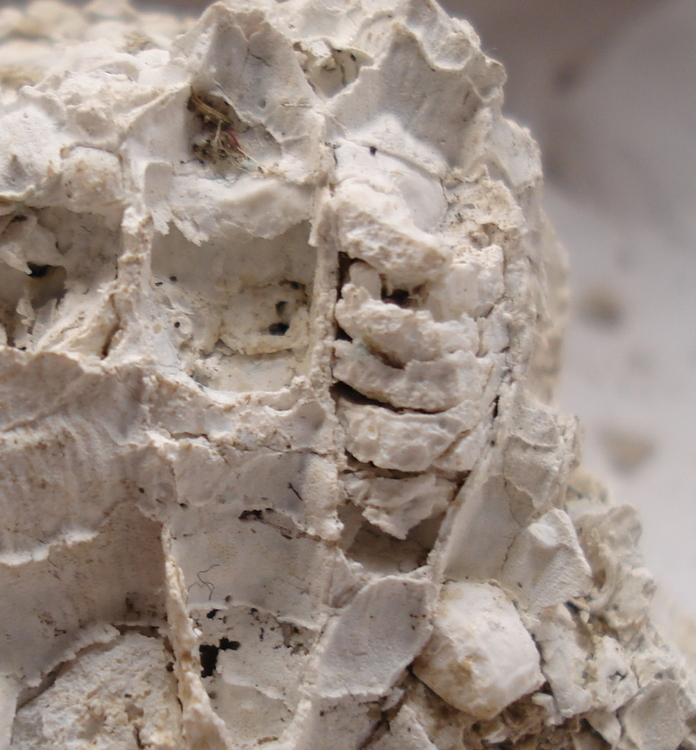
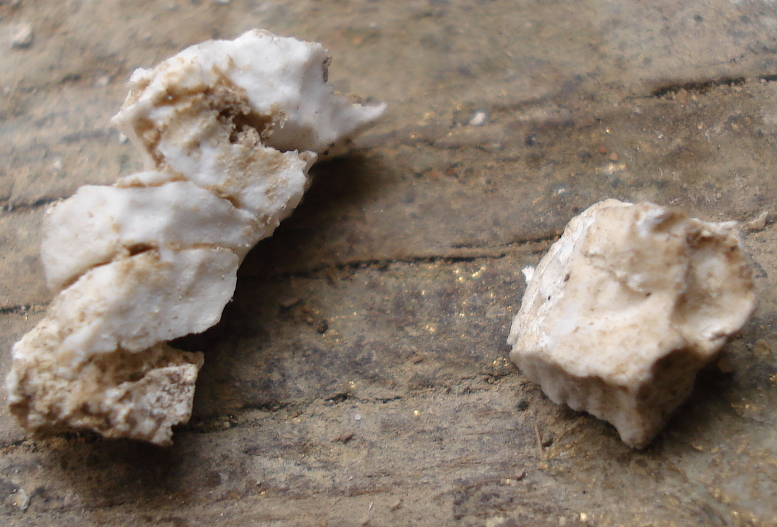
I found one piece of this stuff with somewhat intact characteristics, (pix #1 and #2) and then found a picture of coral which resembled that pretty well, but on an architectural page illustrating hexagonal and polygonal forms for building (http://design.epfl.ch/piraeus/2-day-to-day/3-process/cs-coral-i). Tracing that picture brought me to a blog by a cool dude who likes taking pictures underwater in his tropical retirement paradise in Vietnam (http://www.messersmith.name/wordpress/2009/01/02/ocean-patterns/) if I am interpreting that correctly. Better pix:

Anyway, nobody has a species name though the architecurals are calling it star coral. Maybe a coral specuialist here can help. So this appears to be a deteriorated form of something (Montastrea, Favosites, Orbicella?). It is pretty common on the Ballast Point reef of the Tampa Formation, which I think is shallow water stuff, versus deepwater stuff. In the last two pictures the reader can see a phenomena common to this type of specimen also, these little polygonal or hexagonal discus type thingies are "Stacked" in the tubes of the coral, and can be removed a lot of the time, unless the specimen is extremely well silicified.
Again, thanks for looking, any help greatly appreciated.
Innocentx finds this informative

Odd Coral Type From Tampa
Started by
luxefaire,
36 posts in this topic
Are you aware that tabulate corals went extinct at the end of the Paleozoic? That there is a 250 million year gap between the extinction of the true tabulates and the fossil reef at Tampa? It is highly unlikely that tabulate corals such as Favosites persisted undetected anywhere in the world for 250 million years, popped up in a coral reef in Florida 4 or 5 million years ago, and then went extinct for good (none have been found in modern oceans). It is much more likely that the resemblance is superficial, an artifact of the mode of preservation of a totally different coral.On 12/23/2016 at 5:51 PM, Innocentx said:A lot of similarities. The evidence continues to build.
http://www.lakeneosho.org/Paleolist/87/index.html
Don
i remember that coming up on the front page don, thanks to both for
keeping up....heres a dose of dummy for you don, is the reason the
corals are called tabulate because they have these tabs in the
tubes?....there is a lot of interesting info on that page from
innocentx. there is an advantage sometimes being as ignorant as me, but
with a strong will to learn, because its hard to be embarrassed under
those circumstances, and can lead to thoughts otherwise unconsidered. I
remember when I took on learning byzantine coinage, i was like : no
way. but it happened with persistence and so i tackled 4th crusade
coins of the holy land, the ones they melted down church statues to
make, real gnarly....I got them too eventually, and lots more now, so
the coral will happen in direct proportion to the time i can spend with
it. i would like to identify this species though because i can then
sell the specimens, you see, something banal but useful.
my best chance at id'ing this species is the pix added earlier, of the intact portion of the fossil. I will continue to work on this and thanks again....
I am researching this type of coral now, as the piece i have with preserved exterior closely resembles these.....
Regnum: Animalia
Phylum: Cnidaria
Classis: Anthozoa
Subclassis: Hexacorallia
Ordo: Scleractinia
Familia: Faviidae
btw i added more pix to the blog of coral types, two years after and i just now getting to the information aspect of it....b
my best chance at id'ing this species is the pix added earlier, of the intact portion of the fossil. I will continue to work on this and thanks again....
I am researching this type of coral now, as the piece i have with preserved exterior closely resembles these.....
Faviidae
Favites sp.
Taxonavigation
Superregnum: EukaryotaRegnum: Animalia
Phylum: Cnidaria
Classis: Anthozoa
Subclassis: Hexacorallia
Ordo: Scleractinia
Familia: Faviidae
btw i added more pix to the blog of coral types, two years after and i just now getting to the information aspect of it....b
Innocentx finds this informative
Hey Bill, I probably missed something somewhere in these threads but
has Roger Portell at UF seen this stuff and offered any ideas/help?
Regards, Chris
Regards, Chris
hi plantguy, i dont know if he has or not, i would be interested to
speak with him..... i am tracing down a type that fits very well the
preserved piece of this material and it is here: http://www.coralsoftheworld.org/species_factsheets/species_factsheet_summary/3033/
favites billii...joke just a joke....but favites for sure
any other information greatly appreciated, i wonder if the favites like this from the reef there at ballast point is actually another type? i guess that is my next fun, close comparisons, i am learning a lot, thanks for replies....b
favites billii...joke just a joke....but favites for sure
any other information greatly appreciated, i wonder if the favites like this from the reef there at ballast point is actually another type? i guess that is my next fun, close comparisons, i am learning a lot, thanks for replies....b
I sent him some of your photos. Will keep you posted...
Regards, Chris
Regards, Chris
As I was writing that if you really wanted an id contact Roger, Chris replied.
The best website I have found for Cenozoic coral identification is NMITA's Zooxanthellate site NMITA LINK however as you can see by the id keys for individual species it is a highly specialized field. At best you might be able to id to genus as it is heavily dominated by Plio-Pleistocene species.
Mike
The best website I have found for Cenozoic coral identification is NMITA's Zooxanthellate site NMITA LINK however as you can see by the id keys for individual species it is a highly specialized field. At best you might be able to id to genus as it is heavily dominated by Plio-Pleistocene species.
Mike
"A problem solved is a problem caused"--Karl Pilkington
"I was dead for millions of years before I was born and it never inconvenienced me a bit." -- Mark Twain
"I was dead for millions of years before I was born and it never inconvenienced me a bit." -- Mark Twain
Yep, as Mike says contact Roger as hes not seen anything like that from
that locale and hes not able to place/ID them based on the 5 photos I
sent. closeup/cross section, etc. He would need to see them in hand.
Hopefully you all can arrange something. Here's his
email portell@flmnh.ufl.edu
If you are able get an ID please let us know--even if you arent! Thanks for the post---interesting!
Regards, Chris
If you are able get an ID please let us know--even if you arent! Thanks for the post---interesting!
Regards, Chris
thank you Plantguy i will write roger now....i will keep this running
and should be able to get an id....i have 3 or 4 other types that seem
questionable as far as their cataloguing goes, so once this one is
done....take care and thanks again....b
Thanks trisk, these fossils from Tampa certainly have something like a
tabulate form within, but thats apparently not possible, and has
occurred elsewhere geologically versus biologically...i am happy I was
able to get the one specimen with the intact polyps, as pictured
earlier, and I am including more pictures here with highlights of the
actual corals that allowed me to make a tentative attribution of Favites
(billii....hee hee)
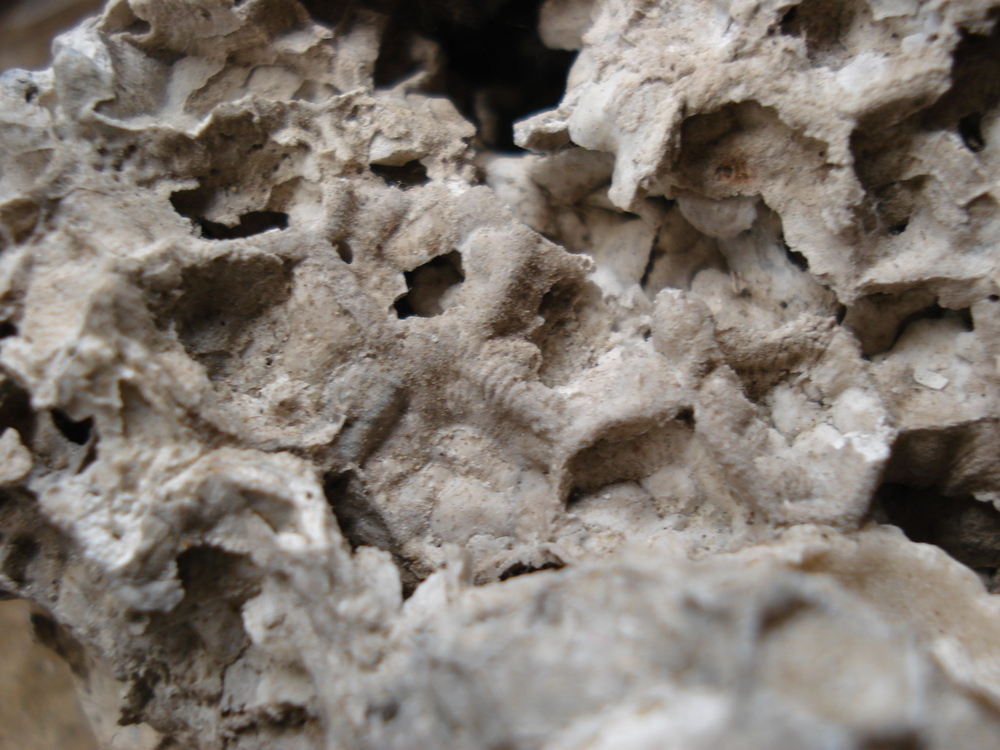
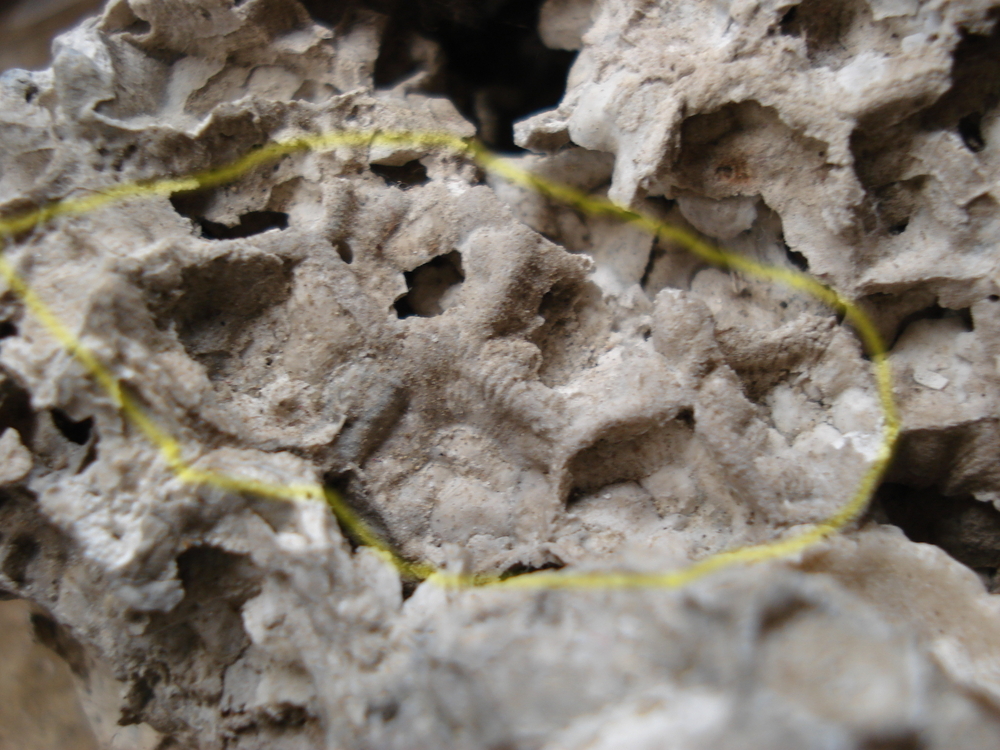
Innocentx finds this informative









This page definitely has all of the information and
ReplyDeletefacts I wanted about this subject and didn't know who to
ask.
this page is a mess, its more an archive. if you want a copy of the book let me know, that is more pix and less html craziness....b
ReplyDelete